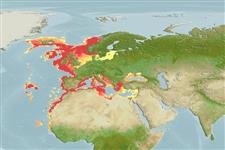Environment: milieu / climate zone / rango de profundidad / distribution range
Ecología
marino demersal; oceanodromo (Ref. 51243); rango de profundidad 0 - 1171 m (Ref. 56504). Temperate; 68°N - 12°N, 32°W - 42°E
Eastern Atlantic: Norway and Iceland to Senegal. Also in the Mediterranean and Black Sea.
Length at first maturity / Tamaño / Peso / Age
Madurez: Lm 200.0 range ? - ? cm
Max length : 300 cm TL macho / no sexado; (Ref. 4453); common length : 100.0 cm TL macho / no sexado; (Ref. 4645); common length :150 cm TL (female); peso máximo publicado: 110.0 kg (Ref. 35388)
Short description
Claves de identificación | Morfología | Morfometría
Found on rocky and sandy bottoms (Ref. 12382). Depth range from 0-500 m (Ref. 4453) and from 305-1171 m in the eastern Ionian Sea (Ref. 56504). It stays near the coast when young and moves toward deeper waters upon reaching adulthood (Ref. 5377). A nocturnal (Ref. 12382) predator of fish, crustaceans, and cephalopods (Ref. 6521). Like other species of the group, it reproduces only once in its life (Ref. 5377). Sexually mature at an age of 5-15 years. Spawn in summer in the Atlantic off Portugal and in the Mediterranean. Produces 3-8 million of eggs (Ref. 35388). Marketed fresh and frozen. Eaten fried and baked (Ref. 9988).
Eggs are deposited in the open sea, at depths between 2,000 and 3,000 m (Ref. 12382).
Smith, D.G., 1990. Congridae. p. 156-167. In J.C. Quero, J.C. Hureau, C. Karrer, A. Post and L. Saldanha (eds.) Check-list of the fishes of the eastern tropical Atlantic (CLOFETA). JNICT, Lisbon; SEI, Paris; and UNESCO, Paris. Vol. 1. (Ref. 4453)
IUCN Red List Status (Ref. 130435: Version 2024-2)
Threat to humans
Reports of ciguatera poisoning (Ref. 30911)
Human uses
Pesquerías: comercial; pesca deportiva: si; Acuario: Acuarios públicos
Herramientas
Special reports
Download XML
Fuentes de Internet
Estimates based on models
Preferred temperature (Referencia
123201): 4.4 - 14.4, mean 8.7 °C (based on 480 cells).
Phylogenetic diversity index (Referencia
82804): PD
50 = 0.5000 [Uniqueness, from 0.5 = low to 2.0 = high].
Bayesian length-weight: a=0.00046 (0.00035 - 0.00059), b=3.26 (3.20 - 3.32), in cm total length, based on LWR estimates for this species (Ref.
93245).
Nivel trófico (Referencia
69278): 4.3 ±0.4 se; based on diet studies.
Generation time: 17.4 ( na - na) years. Estimated as median ln(3)/K based on 1
growth studies.
Resiliencia (Referencia
120179): Bajo, población duplicada en un tiempo mínimo de 4.5-14 años (K=0.06; tm=5-15 (female tm>10); Fec=3,000,000).
Prior r = 0.35, 95% CL = 0.23 - 0.53, Based on 7 data-limited stock assessments.
Fishing Vulnerability (Ref.
59153): Very high vulnerability (86 of 100).
🛈
Climate Vulnerability (Ref.
125649): Moderate vulnerability (38 of 100).
🛈
Nutrients (Ref.
124155): Calcium = 10.9 [6.6, 19.9] mg/100g; Iron = 0.259 [0.148, 0.441] mg/100g; Protein = 18.2 [15.3, 21.1] %; Omega3 = 0.482 [0.219, 1.328] g/100g; Selenium = 39.3 [20.9, 74.7] μg/100g; VitaminA = 8.33 [2.17, 33.01] μg/100g; Zinc = 0.278 [0.200, 0.398] mg/100g (wet weight); based on
nutrient studies.
